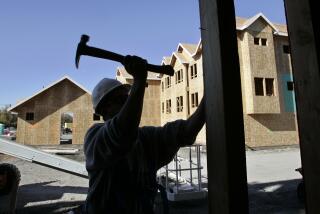Factory Output Climbs in July as Demand Lowers Inventories
- Share via
The U.S. factory sector grew more than expected in July, heralding a strong start for the economy in the third quarter, according to a survey released Monday, while June housing data presented a mixed picture.
The Institute for Supply Management’s factory survey index rose to 56.6 in July from 53.8 in June. The median forecast of economists polled by Reuters put the index at 54.5. Strong growth in July was reported by industries dealing in such commodities as petroleum, textiles, food and wood.
“It’s all systems go in manufacturing,” said Kurt Karl, chief economist at Swiss Re in New York. “We had that slump, and now it’s back in the mid-50s, so this is a very strong report.”
A reading above 50 signals expansion, while a reading below 50 indicates contraction.
Factory production slowed earlier in the year, raising concerns that the U.S. economy was entering a soft patch.
But economists noted that manufacturing indexes had indicated renewed strength in the last couple of months, and most analysts now chalk up the earlier weakness to inventory adjustment after a buildup in stocks early in the year.
According to government growth data released Friday, companies drew down inventories at a $6.4-billion annual rate during the second quarter after boosting them by $58.2 billion in the first quarter.
“What is apparent is that the extra consumer demand that we saw through June is helping to clean up an inventory backup and has paved the way for a production increase,” said Ken Mayland, president of ClearView Economics in Pepper Pike, Ohio. “And all this has occurred with less pressure on prices.”
The factory report’s index of prices paid fell to 48.5 in July from 50.5 in June, marking the end of 40 consecutive months of higher prices.
The institute’s new-orders index, a signal of future growth, rose to 60.6 from 57.2 in June.
Separately, the Commerce Department reported that U.S. construction spending fell 0.3% in June, the fourth consecutive monthly drop. Outlays fell to a seasonally adjusted annual rate of $1.093 trillion, government data showed. Analysts were expecting a 0.5% gain. Construction spending has fallen 3.1% from the high hit in February.
However, the National Assn. of Realtors reported that pending sales of previously owned homes rose in June, indicating that home sales in July and August may edge higher.
More to Read
Inside the business of entertainment
The Wide Shot brings you news, analysis and insights on everything from streaming wars to production — and what it all means for the future.
You may occasionally receive promotional content from the Los Angeles Times.










